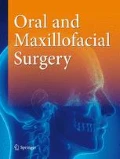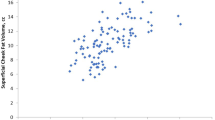Abstract
Purpose
The selection of candidates for buccal fat pad (BFP) removal depends on the patient’s requirements, the subjective surgeons’ evaluation, and objective clinical factors. This cross-sectional observational study aimed to identify objective clinical and ultrasonographic parameters as indicators of cheek contouring with BFP excision.
Methods
Sixty-six patients with cheek fullness complaints were examined by two experienced surgeons to determine if they were good candidates for the procedure. Thereafter, participants underwent clinical and ultrasonographic assessments in a separate session to aid in the surgical decision-making. The association between the clinical judgment for BFP excision and the study variables was analyzed individually and adjusted for confounders using binary logistic regression and grouping analyses.
Results
Forty-nine participants were regarded as suitable and 17 as non-suitable for the procedure. After regression analysis, cheek skin-fold thickness > 6.00 mm, midfacial contour > 2.20 mm, ovoid/triangular facial form, and ultrasonographic BFP volume > 2.05 mL remained as robust individual indicators for the suitability for the procedure. However, the grouping analysis showed that patients having three-to-four significant criteria synchronously had significantly higher odds for eligibility with excellent discrimination capability.
Conclusion
Although high values of cheek skin-fold thickness, midfacial contour, and ultrasonographic BFP volume, as well as an ovoid/triangular facial form, might be robust indicators for the suitability for BFP excision, the surgical decision-making should not be based on isolated parameters. Instead, those patients possessing a combination of at least three of these specific eligibility criteria above the threshold value might be considered the best candidates for the procedure.




Similar content being viewed by others
Data availability
All data will be made available to the editorial board upon request.
References
Zhang HM, Yan YP, Qi KM, Wang JQ, Liu ZF (2002) Anatomical structure of the buccal fat pad and its clinical adaptations. Plast Reconstr Surg 109(7):2509–2518. https://doi.org/10.1097/00006534-200206000-00052 (discussion 2519–2520)
Moura LB, Spin JR, Spin-Neto R, Pereira-Filho VA (2018) Buccal fat pad removal to improve facial aesthetics: an established technique? Med Oral Patol Oral Cir Bucal 23:e478–e484. https://doi.org/10.4317/medoral.22449
Stuzin JM, Wagstrom L, Kawamoto HK, Baker TJ, Wolfe SA (1990) The anatomy and clinical applications of the buccal fat pad. Plast Reconstr Surg 85:29–37. https://doi.org/10.1097/00006534-199001000-00006
Dubin B, Jackson IT, Halim A, Triplett WW, Ferreira M (1989) Anatomy of the buccal fat pad and its clinical significance. Plast Reconstr Surg 83:257–264. https://doi.org/10.1097/00006534-198902000-00009
Loukas M, Kapos T, Louis RG, Wartman C, Jones A, Hallner B (2006) Gross anatomical, CT and MRI analyses of the buccal fat pad with special emphasis on volumetric variations. Surg Radiol Anat 28:254–260. https://doi.org/10.1007/s00276-006-0092-1
Sezgin B, Tatar S, Boge M, Ozmen S, Yavuzer R (2019) The excision of the buccal fat pad for cheek refinement: volumetric considerations. Aesthet Surg J 39:585–592. https://doi.org/10.1093/asj/sjy188
Blal K, Alterman M, Abu Tair J (2020) A pedicled palatal periosteal flap for the closure of oro-antral fistula. Int J Oral Maxillofac Surg 49:1087–1091. https://doi.org/10.1016/j.ijom.2020.01.014
Kim JT, Sasidaran R (2017) Buccal fat pad: an effective option for facial reconstruction and aesthetic augmentation. Aesthetic Plast Surg 41:1362–1374. https://doi.org/10.1007/s00266-017-0962-4
Adeyemo WL, Ibikunle AA, James O, Taiwo OA (2019) Buccal fat pad: a useful adjunct flap in cleft palate repair. J Maxillofac Oral Surg 18:40–45. https://doi.org/10.1007/s12663-018-1100-9
Gaba S, Sharma RK, Rattan V, Khandelwal N (2012) The long-term fate of pedicled buccal pad fat used for interpositional arthroplasty in TMJ ankylosis. J Plast Reconstr Aesthet Surg 65:1468–1473. https://doi.org/10.1016/j.bjps.2012.05.016
Bansal V, Bansal A, Mowar A, Gupta S (2015) Ultrasonography for the volumetric analysis of the buccal fat pad as an interposition material for the management of ankylosis of the temporomandibular joint in adolescent patients. Br J Oral Maxillofac Surg 53:820–825. https://doi.org/10.1016/j.bjoms.2015.06.019
Matarasso A (2006) Managing the buccal fat pad. Aesthet Surg J 26:330–336. https://doi.org/10.1016/j.asj.2006.03.009
Matarasso A (1997) Pseudoherniation of the buccal fat pad: a new clinical syndrome. Plast Reconstr Surg 100:723–730. https://doi.org/10.1097/01.PRS.0000086080.81468.4A (discussion 731–736)
De Greef S, Vandermeulen D, Claes P, Suetens P, Willems G (2009) The influence of sex, age and body mass index on facial soft tissue depths. Forensic Sci Med Pathol 5:60–65. https://doi.org/10.1007/s12024-009-9085-9
Matarasso A (1991) Buccal fat pad excision: aesthetic improvement of the midface. Ann Plast Surg 26:413–418. https://doi.org/10.1097/00000637-199105000-00001
Swift A, Remington K (2011) BeautiPHIcation™: a global approach to facial beauty. Clin Plast Surg 38:347–377. https://doi.org/10.1016/j.cps.2011.03.012
Ramirez OM (2001) Full face rejuvenation in three dimensions: a “face-lifting” for the new millennium. Aesthetic Plast Surg 25:152–164. https://doi.org/10.1007/s002660010114
Aradya A, Chowdhary R (2017) Re-evaluation of interarch space determination in fully dentate adults with different facial forms: a clinical study. Indian J Dent Res 28:613–616. https://doi.org/10.4103/ijdr.IJDR_625_15
Mommaerts M, Steyaert L, Polsbroek R, Correia P (2004) Correlation between ultrasound and radiographic data for assessment of symphyseal bony callus maturation after distraction. Rev Stomatol Chir Maxillofac 105:19–22. https://doi.org/10.1016/s0035-1768(04)72908-3
Bailey KV, Ferro-Luzzi A (1995) Use of body mass index of adults in assessing individual and community nutritional status. Bull World Health Organ 73:673–680
Sarver D, Jacobson RS (2007) The aesthetic dentofacial analysis. Clin Plast Surg 34:369–394. https://doi.org/10.1016/j.cps.2007.05.008
Franco FC, de Araujo TM, Vogel CJ, Quintão CC (2013) Brachycephalic, dolichocephalic and mesocephalic: is it appropriate to describe the face using skull patterns? Dental Press J Orthod 18:159–163. https://doi.org/10.1590/s2176-94512013000300025
Gravante G, Lo Grasso S (1997) Bichat’s fat-pad: correlations with some anthropometric parameters. Ann Hum Biol 24:181–185. https://doi.org/10.1080/03014469700004912
Hinderer UT (1975) Malar implants for improvement of the facial appearance. Plast Reconstr Surg 56(2):157–165. https://doi.org/10.1097/00006534-197508000-00007
Dayan S, Romero DH (2018) Introducing a novel model: the special theory of relativity for attractiveness to define a natural and pleasing outcome following cosmetic treatments. J Cosmet Dermatol 17:925–930. https://doi.org/10.1111/jocd.12732
Figueroa C (2003) Self-esteem and cosmetic surgery: is there a relationship between the two? Plast Surg Nurs 23:21–24. https://doi.org/10.1097/00006527-200323010-00005
Thomas MK, D’Silva JA, Borole AJ (2012) Facial sculpting: comprehensive approach for aesthetic correction of round face. Indian J Plast Surg 45:122–127. https://doi.org/10.4103/0970-0358.96608
Nahai F (2019) Do we need to develop critical outcome sets? Aesthet Surg J 39:813–814. https://doi.org/10.1093/asj/sjz117
Wan D, Amirlak B, Giessler P, Rasko Y, Rohrich RJ, Yuan C, Lysikowski J, Delgado I, Davis K (2014) The differing adipocyte morphologies of deep versus superficial midfacial fat compartments: a cadaveric study. Plast Reconstr Surg 133:615e–622e. https://doi.org/10.1097/PRS.0000000000000100
Kahn JL, Wolfram-Gabel R, Bourjat P (2000) Anatomy and imaging of the deep fat of the face. Clin Anat 13:373–382. https://doi.org/10.1002/1098-2353(2000)13:5%3c373::AID-CA7%3e3.0.CO;2-W
Raskin E, Latrenta GS (2007) Why do we age in our cheeks? Aesthet Surg J 27:19–28. https://doi.org/10.1016/j.asj.2006.12.003
Ruzhitska O, Kucher A, Vovk V, Vovk Y, Pohranychna K (2020) Clinical sonographic analysis of biometric indicators of buccal thickness and buccal fat pad in patients with different facial types. Georgian Med News 302:49–53
Funding
This study has been supported by the Technical Research Council of the Faculty of Dentistry of the University of Antioquia (CIFO-Code 2018–22350).
Author information
Authors and Affiliations
Contributions
Cardona-Gómez N. participated in the design of the study, accomplished the recording of clinical data, analysis of the results, and was involved in drafting the manuscript. Gil-Cárdenas FA and Cardona-Estrada JI participated in its design, patient’s classification, and manuscript preparation. Molina-Cárdenas EA performed the ultrasonographic evaluation of the patients and was involved in the manuscript preparation. Tobón-Arroyave SI handled the study concepts and design, supervised the acquisition of the data, accomplished the analysis and interpretation of data, and critically evaluated and supplemented the manuscript. All the authors read and approved the final manuscript.
Corresponding author
Ethics declarations
Ethical approval
This study was approved by the Institutional Ethics Committees for Human Studies of the University of Antioquia (Concept Number 03–2019) and San Vicente Foundation University Hospital (Reference number 02–2018).
Consent to participate
Written consent was obtained for all participants in this study.
Consent for publication
All the authors give consent for the publication of this work.
Conflict of interest
The authors declare no competing interests.
Additional information
Publisher's note
Springer Nature remains neutral with regard to jurisdictional claims in published maps and institutional affiliations.
Rights and permissions
About this article
Cite this article
Cardona-Gómez, N., Gil-Cárdenas, F.A., Molina-Cárdenas, E.A. et al. Assessment of clinical and ultrasonographic parameters as indicators for buccal fat pad excision by esthetic reasons. Oral Maxillofac Surg 27, 151–161 (2023). https://doi.org/10.1007/s10006-022-01043-4
Received:
Accepted:
Published:
Issue Date:
DOI: https://doi.org/10.1007/s10006-022-01043-4




